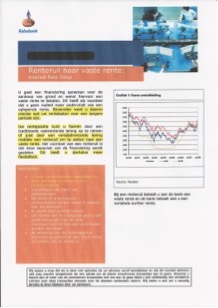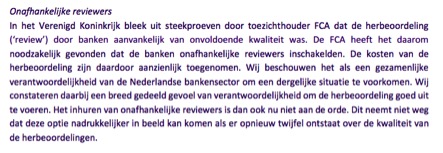| 10-3-2017 | Carlo de Meijer |
 Since the first meetings organised by the Technology Advisory Committee of the US Commodity Futures Trading Commission (CFTC) on January 26 and February 23, 2016, on “Blockchain and the Potential Application of Distributed Ledger Technology to the Derivatives Market”, we have seen a lot of activity in this area.
Since the first meetings organised by the Technology Advisory Committee of the US Commodity Futures Trading Commission (CFTC) on January 26 and February 23, 2016, on “Blockchain and the Potential Application of Distributed Ledger Technology to the Derivatives Market”, we have seen a lot of activity in this area.
The Depository Trust and Clearing Corporation (DTCC) last month – so a year later – launched its plans to develop a blockchain-based post-trade framework for derivatives processing with tech firms R3, IBM and Axoni starting in January. The US-based clearing institute aims to replace the technology underpinning its Trade Information Warehouse database with a distributed ledger. The announcement by DTCC of its plan to transition its Trade Information Warehouse (TIW), into a blockchain platform is described as a “watershed moment” for the industry in deploying distributed ledger technology (DLT) in production at this scale and a “reimagining” of credit derivatives processing.
DTCC and TIW
But for an idea of the scale of this operation, first something about DTCC and TIW. The Depository and Clearing Corporation focuses on post-trade financial services, providing clearing and settlement services to the financial markets. It provides central custody of securities and ways for buyers and sellers to make their exchanges in a safe and efficient way.
The Trade Information Warehouse (TIW) , a central part of its financial infrastructure, and a a major component in the credit derivatives market, currently automates recordkeeping and other workflow functions, such as lifecycle events and payment management for more than $11 trillion of cleared and bilateral credit derivatives annually, among 2,500 buy-side firms located in more than 70 countries. This is roughly 98% of all transactions in that asset class.
DTCC involvement with blockchain
DTCC has been in the forefront of early-stage experimentation, notwithstanding this technology could disrupt this industry and might make obsolete or reduce the role of a number of clearing and other business parties in the post trade market infrastructure. Already end 2015 DTCC expressed its interest in blockchain technology and became a founding member of the Hyperledger Project, an open-source blockchain development project managed by The Linux Foundation and aimed at driving the adoption and standardization of distributed ledger technology in the financial services sector. Last year DTCC also invested in and partnered with Digital Asset Holdings (DAH).
The decision to go ahead with a blockchain-powered “revamp” of the DTCC’s Trade Information Warehouse follows a successful trial of this technology by the company last year. In April 2016, DTCC announced the successful completion of a proof of concept of blockchain technology and smart contracts to manage post-trade lifecycle events for standard North American single-name credit default swaps (CDS) in partnership with Axoni, Markit, Bank of America Merrill Lynch, Citi, Credit Suisse and JPMorgan.
Soon after their partnership, DTCC and DAH started a collaboration to develop and test blockchain-based solutions for the $2.6 trillion US repurchase agreement (repo) market. DTCC and DAH said “they wanted to streamline U.S. Treasury, Agency and Agency Mortgage-Backed repo transactions and thereby lower costs and risks”.
The DTCC TIW blockchain project
In their plans the DTCC’s Trade Information Warehouse is to be “re-platformed” through a distributed ledger framework based on blockchain technology to drive further improvements in derivatives post-trade lifecycle events. The project has been developed with input and guidance from a number of market participants including Barclays, Citi, Credit Suisse, Deutsche Bank, JP Morgan, UBS and Wells Fargo, and infrastructure providers IHS Markit and Intercontinental Exchange. These parties helped develop the technology by providing workflow guidance. The final goal of the project is to develop a permissioned distributed ledger network for derivatives, governed by DTCC, with peer nodes at participating firms.
The whole project is a cooperative effort of a number of partners. By mid-2016, the DTCC submitted a request for proposal (RFP) for interested parties to “re-platform” the warehouse and cut back on reconciliation costs. DTCC has selected a series of firms including IBM, startup Axoni and bank-backed R3CEV to help integrate distributed ledger technology into its first large-scale, real-world application.
Under the DTCC agreement, IBM is the primary contract holder for the DTCC implementation and will lead the initiative, provide program management, contribute DLT expertise and integration services as well serving as the solution-as-a-service (SaaS) provider. Axoni is to provide distributed ledger infrastructure and smart contract applications, while the blockchain bank-backed consortium R3CEV is acting as a “solution advisor” from both a technological perspective and from a banking workflow perspective. R3 is thereby charged with “really helping validate that the architecture is sound, but also making sure that the feedback from this big R3 global network is heard”.
“The combined expertise of IBM and our partners enables us to provide DTCC with a resilient, open and innovative new technology platform to support this groundbreaking opportunity.” Bridget van Kralingen, SVP IBM Industry Platforms.
Development on the technology started in January and is expected to go live in early 2018. Over the course of 2017, the partners will work collaboratively to “re-platform” the existing Trade Information Warehouse (TIW) to a permissioned distributed ledger network custom-built for cleared and bilateral credit derivatives – governed by industry-owned DTCC with peer nodes at participating firms.
“It enables a distributed network to be built on this where, ultimately, participants could have nodes in-house,” Schvey, Axoni.
The distributed ledger technology being used for the DTCC TIW project is the AxCore protocol, created by New York-based Axoni. Deployment of the AxCore protocol will be done in phases, and even after it goes live next year, may only be adopted slowly. When the AxCore protocol goes live in early 2018, Axoni intends to submit the software to Hyperledger Project.
Rollout of the new blockchain-powered platform won’t be immediate. Initially, the distributed ledger will run in parallel with the existing settlement infrastructure. The latter can take as long as a week to close compared to the nearly instant settlement times expected from the blockchain solution. Upon launch, the DTCC will run a node that updates the TIW ledger, and other participants will also be able to run a node to support the network or to just get a feed of the information. “Not all of our clients will be moving into the world of distributed ledger at the same pace”. Large participating firms are expected to run their own individual “peer nodes” on the private ledger, with smaller DTCC clients being given the option to tap into DTCC’s own node.
By the time the Axoni technology is fully implemented, the entire life-cycle of a credit derivative will be captured as a smart contract or a “suite of smart contracts”.
Main goals ….
The new-to-create blockchain-powered platform is intended to enable DTCC and its clients to further streamline, automate and reduce the cost of derivatives processing across the industry by removing the need for “disjointed, redundant processing capabilities and the associated reconciliation costs”.
The present processes are arduous with current paper contracts in the form of computer documents still being issued. Blockchain and smart contract technology that will allow buyers, sellers and central clearing houses of derivative trades to share information, such as KYC (Know Your Customer), in real time across various distributed ledger platforms, may unleash great efficiencies. At scale, peer-to-peer networks that secure digital assets would allow parties to identify, transact, and settle with each other in expedited workflows.
- Streamline derivatives processing
“Distributed ledger technology is a natural fit for derivatives processing. By recording and automatically managing shared records of financial agreements in the cloud without error, it can minimize the steps required for post-trade processing and free up middle- and back-office staff from the onerous task of reconciliation.” Rutter R3CEV
- Improvement to settlement times
With regard to the settlement of derivative transactions, presently the system entails a three to five day process involving many third parties. This represents a significant opportunity cost that parties can recapture with a blockchain-based system that enables even real-time settlement.
“In a future where they move their infrastructure from what I imagine is a complex environment of interconnected software with a ton of proprietary adapters and middleware to a blockchain, the cost savings and improvement to settlement time – currently as long as a week for some of DTCC’s trades -will be pretty monumental to their business.”
- Cost saving
Blockchains are “uniquely suited” to reduce costs associated with reconciliations, settlement, and security. According to industry executives cost savings can come from eliminating redundant IT systems and trading and risk management overhead. The finance industry currently spends roughly $150 billion annually on IT and operations expenditures in addition to $100 billion on post-trade and securities servicing fees. A 2015 report by Santander estimated the global savings to banks more generally speaking could be as high as $20bn a year.
To provide an example, parties that own identical records in a single, shared ledger would reap explicit cost savings around reconciliations. Similarly, parties that transact obligations in a wholly digital, peer-to-peer network underpinned by such a ledger would reap explicit cost savings around settlement activities as well. Furthermore, parties would be able to manage implicit costs in different ways, like exceptions management, regulatory reporting, know-your-customer (KYC) and anti-money laundering (AML) that stand to be streamlined in ways that provide maximum value in a peer-to-peer workflow.
… and other possible opportunities
Other possible benefits of the use of blockchain in the derivative space include increased transparency, lower counterparty risk, and easier accounting. This may ultimately lead to lower collateral needs and improved liquidity.
- Improved transparency
In addition to providing streamlined processing by supporting self-executing code, or smart contracts, it is “widely heralded as a bastion of transparency”. This is especially relevant for regulatory bodies. Since the distributed ledger’s record is immutable, a regulatory node has the potential to give government observers access to real-time data about transactions, instead of having to wait for reports from market participants.
- Improved risk management
The use of blockchain technology for derivatives could also improve risk management. It could provide market participants a degree of control over risk and versatility over the balance sheet that is unachievable with today’s paper assets. As an example, parties might consider cash flow exchanges every 30 seconds instead of every 30 days, reducing counterparty and credit risk commensurately, as well as changing how these risks are measured.
- Improved collateral management
Under blockchain, dealers will post collateral to the clearing house in the form of initial and variation margin by escrowing cash on a distributed cash ledger or by allocating assets held on other asset ledgers to a distributed collateral ledger. Smart derivative contracts that bind both seller and buyer will be stored on a distributed derivative ledger along with information from the cash and asset ledgers. This will lead to efficiencies for calculating derivative positions and obligations, leading to lower collateral needs.
- “The smart contract can automatically compute exposures by referencing agreed external data sources (e.g. S&P 500, NASDAQ) that recalculate variation margin. Interoperable derivative and collateral ledgers would automatically allow the contract to call additional collateral units on asset ledgers to support these needs. At maturity, a final net obligation is computed by the smart contract, and a payment instruction automatically generated in the cash ledger, closing out the deal”
- Improved liquidity
Transparency, alongside reduced transaction and trade maintenance costs, could, in turn, enhance trading liquidity. In present situation in order to maintain liquidity levels firms nowadays have to overcompensate where the money has to be tied up for some time before the next transaction. The improvement in funds settlement and counterparty risk assessment in a blockchain environment may shorten the liquidity cycle for various derivative positions, allowing banks to inject liquidity into the system for other transactions much more quickly.
Remaining challenges
Despite all the positives around blockchain and smart contract technology, still many challenges exist. These are mostly the same as for other financial transactions, including lack of scalability, no common standards, no legal and regulatory certainty and the arrival of multiple distributed ledgers. But also smart contracts are at an early stage of development. Defining exactly what they are and how they would work is still a challenge. Regulators and standards bodies across many different industries will need to come together to define what they mean for each transaction and sector.
“The industry assumption is that there should not be one ledger to rule them all, there will be different ledgers and we need to work together to make sure they interoperate, not just from banks.” Braine Barclays
Are there opportunities for derivatives CCPs?
An interesting question is: why is DTCC so active in the blockchain arena: for defensive or offensive reasons? Blockchain technology is seen by many as a disruptive factor for a number of market infrastructure players such as CSDs, repositories and CCPs.
One of the original goals of blockchain technology is to remove the need for central governing bodies. Traditionally, financial exchanges have required clearing houses to provide a guarantee to the winning party of the derivative contract in case the loser does not pay. The clearing house is able to provide this guarantee by requiring both parties to make cash deposits during the pre-trade phase.
The ledger will replace today’s process by which multiple parties reconcile proprietary books and records to accurately represent the custody and value of a financial instrument at any given point in time. With respect to the derivatives markets, blockchains would ultimately come to be used as digital asset registries, as a record residing in a single, shared ledger. So the mechanisms by which parties maintain custody of their obligations and the smart contracts that enshrine those obligations.
….. Yes there are!
A number of industry analysts however reason traders will continue to novate derivative trades via a Counterparty Clearing House (CCP) in order for dealers to net their exposures and monitor the financial well-being of counterparties (ensuring problems like double-spending are eliminated).
Also Nasdaq thinks there are opportunities for derivatives CCPs.
“The concepts of DLT – in its fundamental form with decentralised recording of asset ownership – and derivatives CCP clearing are inherently different. At first, it appears counterintuitive for a derivatives CCP to pursue a technology aimed at decentralising the processing of transactions and removing the need for a CCP. However, derivatives clearing consists of several processes such as position keeping, reconciliation, collateral management, risk and default management, and settlement. While margining and default management do not benefit from a decentralised process, position keeping and settlement could do – and here DLT can increase efficiency.” Fredrik Ekström, Nasdaq’s Clearing President in “Blockchain Tech for Derivatives CCPs — Friend or Foe?”
Final remarks
If this first large-scale implementation of a distributed ledger proves successful, there’s plenty of room to expand. In my mind one should be optimistic of further developments in this space, especially in consideration of the rising cost of reconciliations, post-trade operations, and security issues that market participants confront today.
It seems very likely that the DTCC initiative, once it becomes operational, will have a significant impact on the derivatives world and may open doors to massive adoption of distributed ledger technology for financial services including derivatives.
“This will be one of the first [instances] globally where we are using distributed ledger technology to become a piece of the infrastructure in a very critical market, in the credit default swaps market, and use it across the entirety of multiple players” “By recording transactions in a distributed ledger, everyone uses that same piece of information, that same trade batch, in the same exact way.” DTCC CEO Bodson.
The entire global credit derivatives market in 2016 was $544tn, according to the Bank for International Settlements (BIS), much of which is processed by the DTCC.

Carlo de Meijer
Economist and researcher
 Corporates will save hedging costs and administrative costs significantly if they shift their hedging activities to exchanges such as CME (Chicago Mercantile Exchange).
Corporates will save hedging costs and administrative costs significantly if they shift their hedging activities to exchanges such as CME (Chicago Mercantile Exchange).
 EMIR / Dodd-Frank
EMIR / Dodd-Frank Treasury Services’ analysis:
Treasury Services’ analysis:

 There are lots of discussions concerning risk, but let us start by trying to define what we mean by risk. In today’s article I will focus on liquidity risk. Many companies have very significant credit needs and this needs to be formally addressed with a credit analysis procedure in place. In my former articles I dealt with
There are lots of discussions concerning risk, but let us start by trying to define what we mean by risk. In today’s article I will focus on liquidity risk. Many companies have very significant credit needs and this needs to be formally addressed with a credit analysis procedure in place. In my former articles I dealt with 
 Since the first meetings organised by the Technology Advisory Committee of the US Commodity Futures Trading Commission (CFTC) on January 26 and February 23, 2016, on “Blockchain and the Potential Application of Distributed Ledger Technology to the Derivatives Market”, we have seen a lot of activity in this area.
Since the first meetings organised by the Technology Advisory Committee of the US Commodity Futures Trading Commission (CFTC) on January 26 and February 23, 2016, on “Blockchain and the Potential Application of Distributed Ledger Technology to the Derivatives Market”, we have seen a lot of activity in this area.




 Er staat op dit moment veel in het nieuws over rentederivaten en de ontwikkelingen rond deze producten. Rentederivaten kunnen nuttig zijn om het renterisico af te dekken, het zijn echter ingewikkelde producten. Als treasurer zult u de werking en de risico’s van het product goed begrijpen. Als u toch behoefte heeft aan voorlichting kunt u zich laten informeren door uw bank. Daarnaast kunt u kennis over de werking van deze producten in huis halen, bijvoorbeeld bij een advieskantoor dat zich specialiseert op het gebied van rentederivaten.
Er staat op dit moment veel in het nieuws over rentederivaten en de ontwikkelingen rond deze producten. Rentederivaten kunnen nuttig zijn om het renterisico af te dekken, het zijn echter ingewikkelde producten. Als treasurer zult u de werking en de risico’s van het product goed begrijpen. Als u toch behoefte heeft aan voorlichting kunt u zich laten informeren door uw bank. Daarnaast kunt u kennis over de werking van deze producten in huis halen, bijvoorbeeld bij een advieskantoor dat zich specialiseert op het gebied van rentederivaten. 
 De compensatieregeling voor ondernemers met een rentederivaat blijft stof opwerpen. Gisteren verscheen het nieuws dat de Deutsche Bank zich waarschijnlijk moet verantwoorden voor de rechtbank omdat deze zich als enige weigert aan te sluiten bij de compensatie regeling die onlangs werd voorgesteld door een onafhankelijke commissie. (bron:
De compensatieregeling voor ondernemers met een rentederivaat blijft stof opwerpen. Gisteren verscheen het nieuws dat de Deutsche Bank zich waarschijnlijk moet verantwoorden voor de rechtbank omdat deze zich als enige weigert aan te sluiten bij de compensatie regeling die onlangs werd voorgesteld door een onafhankelijke commissie. (bron: 

 “Bijgaand de standaardteksten bij de advisering/verkoop van een renteswap door de Rabobank. Let op het verschil van 2008 en 2010! In 2008 is het structureel verkocht door te stellen dat de klant ‘een vaste rente gaat betalen’.
“Bijgaand de standaardteksten bij de advisering/verkoop van een renteswap door de Rabobank. Let op het verschil van 2008 en 2010! In 2008 is het structureel verkocht door te stellen dat de klant ‘een vaste rente gaat betalen’.

 Willem van Overveld beschrijft hoe een simpele SWAP constructie zonder margin calls toch lastig kan worden: de menselijk organisatorische kant van derivaten constructies krijgt vaak te weinig aandacht. Een voorbeeld uit de praktijk:
Willem van Overveld beschrijft hoe een simpele SWAP constructie zonder margin calls toch lastig kan worden: de menselijk organisatorische kant van derivaten constructies krijgt vaak te weinig aandacht. Een voorbeeld uit de praktijk: Willem van Overveld – Allround finance / treasury professional
Willem van Overveld – Allround finance / treasury professional


